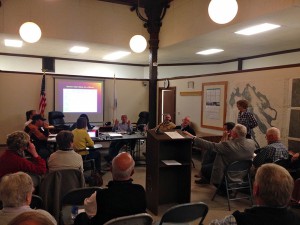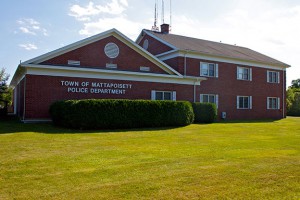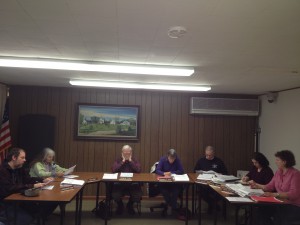Although the two sides inched closer together during two nights of public hearings, the Planning Board and Energy Management Committee failed to reach consensus on Marion’s proposed Solar Bylaw.
As has been the case since the Board of Selectmen signed off on its inclusion in the warrant, the bylaw – which formalizes the process for installing residential solar arrays and recommends a Municipal Solar Overlay District – is in the hands of Town Meeting goers in May.
But the EMC had been seeking the imprimatur of the Planning Board to ease the policy’s passage, while the Planning Board insisted on changes ranging from tweaks to overhauls in the bylaw before issuing an endorsement. Although tensions between the boards have eased, that endorsement never came after three and a half hours of community input and discussion Wednesday, April 17. The third public hearing scheduled for Thursday, April 18, has been cancelled.
“We’ll let this play out at Town Meeting,” said Planning Board Chair Jay Ryder. “We’ll present a letter with our recommendations, and the chips are going to fall where they will.”
Planning Board members Pat McArdle and Ted North, the latter the most vocal opponent of the Solar Bylaw, were absent from the second night of public hearings. Although the testimony from residents on Wednesday was overwhelmingly in favor of the bylaw, its fate seemed as uncertain as ever at times, with talk of postponing consideration until the fall escalating.
EMC member Jennifer Francis dismissed this possibility.
“The reason we’ve made as much progress as we have is because we had a deadline: spring Town Meeting,” she said. “Our intent was not to go off and do this on our own. We did the best job we could, and we really felt like we came up with a solution. We can delay it again and again and again and never get there.”
The next Planning Board meeting is scheduled for May 6, during which time one aspect of the Solar Bylaw could be revisited: a broadened special permit requirement for all ground-mounted residential solar installations that the Planning Board has unanimously called for and that the EMC has up to this point resisted. Although it is unclear whether such an amendment could be attached to the bylaw in time for the Town Meeting – and what form that change would take – officials speculated about the possibility of presenting the bylaw for passage at the Annual Town Meeting, along with a provision implementing a special permit for a fall Town Meeting. “We can’t just agree in principle,” Ryder said. “We have to agree to something in writing.”
The Planning Board favors a special permit requirement because it provides a “meaningful vehicle for neighbors to weigh in,” according to member Tom Magauran, while Francis opposes it for the burdens it would place on applicants.
Marion resident Dan Cooney agreed.
“We should be doing everything we can to be leading the state when it comes to solar,” he said. “A special permit is a big deal for people with kids and jobs, who might not have access to an architect or a friend who is a lawyer. It’s time and money.”
Planning Board member Steve Kokkins argued that the “main issue is being able to have abutters as a formal part of the process, and the different shapes, sizes, and locations of lots. It’s about the flavor of Marion, and being able to evaluate each individual applicant’s situation.”
Kokkins and Magauran referred repeatedly to the challenge of ground-mounted residential solar installations’ recent emergence.
“These are still unfamiliar,” Kokkins said. “Maybe in 10 or 20 years, they’ll be much more familiar.”
But Marion resident Ted Brainard rejected this line of reasoning.
“I’m baffled being here two nights now that we can’t get together and solve this problem,” he said. “You have a very good spec in front of you. Solar has no smoke, no smell, and no noise. The only thing is sight, and they’re going to be screened.
“I suspect that there are audience members and board members who want to kill solar, and a special permit is the perfect place to kill it,” Brainard continued. “I don’t want to see renewable energy cut down like this. If I want renewable energy, I want it.”
Later in the evening, the Planning Board scrutinized the second half of the Solar Bylaw, which would authorize the creation of a Municipal Solar Overlay District on 50 acres of town-owned capped landfill. The overlay could lead to a community solar garden serving residents who lack a suitable solar site or do not possess the resources to purchase equipment.
Francis explained that the capped landfill is an “excellent solar location” because it is a “wasteland” near a power grid, already cleared, and has no shading.
“The overlay eliminates a need for a special permit,” said Francis in her presentation, “but still provides strict oversight via site plan review and DEP post-closure permit. The town would not pay for the DEP permit; the state would.”
The plan would be modeled after Brewster’s successful solar garden, and utilizing the landfill would satisfy one criterion in a potential Green Communities accreditation for Marion, should the town seek such status.
But the specter of the lack of a special permit process returned.
“The risks are low, but they’re not zero,” said Magauran, referring to the possible puncture of the underground waste membrane. “The problem for the board is the by-right. There are tens of millions of dollars of liability on that capped landfill. Who’s going to be responsible for that? Not the developer. The town. This is new stuff. I have no problem with it whatsoever, but I do worry about that landfill. Do it somewhere else.”
Citing similar projects in Fairhaven and elsewhere and noting the fact that the solar installations are lighter than vehicles that traverse the land, the EMC minimized that possibility.
“It’s not as if some green fog is going to float out and consume the town,” said Chair Bill Saltonstall.
Still, the Planning Board expressed serious concern that Marion might be cut out of the process, aside from leasing the land to the developer, and that some residents could be left out given the solar garden’s limited capacity. With various members voicing various problems with the proposal, it became clear that the board’s support of the Municipal Solar Overlay District is unlikely at best.
As the night drew to a close, Claude Hoopes, a supporter of the Solar Bylaw, advised Francis and the EMC to “find answers” before the Town Meeting, fearing for its passage as “larger questions and fear of the unknown linger in the conscience of the citizenry.”
If a bylaw fails to receive a two-thirds majority at Town Meeting, officials may not resubmit it for two years.
The next Planning Board meeting is scheduled for May 6. The Town Meeting begins May 13.
By Shawn Badgley






